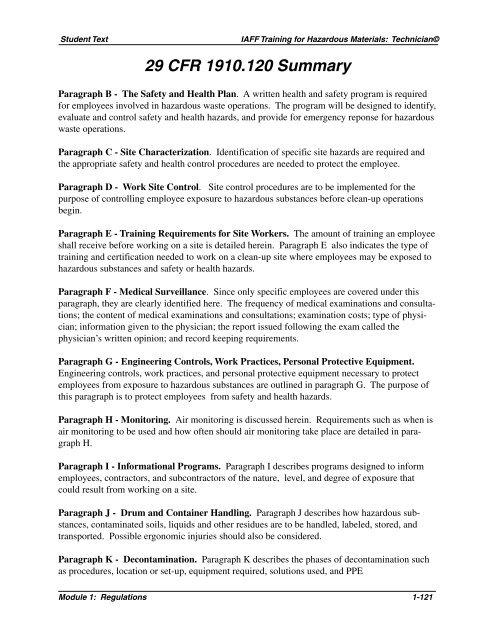Module 1: Regulations - International Association of Fire Fighters
Module 1: Regulations - International Association of Fire Fighters
Module 1: Regulations - International Association of Fire Fighters
You also want an ePaper? Increase the reach of your titles
YUMPU automatically turns print PDFs into web optimized ePapers that Google loves.
Student Text IAFF Training for Hazardous Materials: Technician©<br />
29 CFR 1910.120 Summary<br />
Paragraph B - The Safety and Health Plan. A written health and safety program is required<br />
for employees involved in hazardous waste operations. The program will be designed to identify,<br />
evaluate and control safety and health hazards, and provide for emergency reponse for hazardous<br />
waste operations.<br />
Paragraph C - Site Characterization. Identification <strong>of</strong> specific site hazards are required and<br />
the appropriate safety and health control procedures are needed to protect the employee.<br />
Paragraph D - Work Site Control. Site control procedures are to be implemented for the<br />
purpose <strong>of</strong> controlling employee exposure to hazardous substances before clean-up operations<br />
begin.<br />
Paragraph E - Training Requirements for Site Workers. The amount <strong>of</strong> training an employee<br />
shall receive before working on a site is detailed herein. Paragraph E also indicates the type <strong>of</strong><br />
training and certification needed to work on a clean-up site where employees may be exposed to<br />
hazardous substances and safety or health hazards.<br />
Paragraph F - Medical Surveillance. Since only specific employees are covered under this<br />
paragraph, they are clearly identified here. The frequency <strong>of</strong> medical examinations and consultations;<br />
the content <strong>of</strong> medical examinations and consultations; examination costs; type <strong>of</strong> physician;<br />
information given to the physician; the report issued following the exam called the<br />
physician’s written opinion; and record keeping requirements.<br />
Paragraph G - Engineering Controls, Work Practices, Personal Protective Equipment.<br />
Engineering controls, work practices, and personal protective equipment necessary to protect<br />
employees from exposure to hazardous substances are outlined in paragraph G. The purpose <strong>of</strong><br />
this paragraph is to protect employees from safety and health hazards.<br />
Paragraph H - Monitoring. Air monitoring is discussed herein. Requirements such as when is<br />
air monitoring to be used and how <strong>of</strong>ten should air monitoring take place are detailed in paragraph<br />
H.<br />
Paragraph I - Informational Programs. Paragraph I describes programs designed to inform<br />
employees, contractors, and subcontractors <strong>of</strong> the nature, level, and degree <strong>of</strong> exposure that<br />
could result from working on a site.<br />
Paragraph J - Drum and Container Handling. Paragraph J describes how hazardous substances,<br />
contaminated soils, liquids and other residues are to be handled, labeled, stored, and<br />
transported. Possible ergonomic injuries should also be considered.<br />
Paragraph K - Decontamination. Paragraph K describes the phases <strong>of</strong> decontamination such<br />
as procedures, location or set-up, equipment required, solutions used, and PPE<br />
<strong>Module</strong> 1: <strong>Regulations</strong> 1-121
















